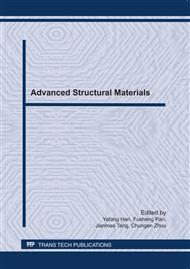p.235
p.242
p.247
p.253
p.260
p.265
p.271
p.276
p.280
Microstructures and Mechanical Properties of As-Cast and Extruded Mg-2wt.%Zn Alloy Containing Dilute Content of Misch Metal
Abstract:
Microstructures and Mechanical Properties of as-cast and extruded Mg–2wt.%Zn alloys containing dilute misch metal were investigated. RE additions were added in the form of relatively inexpensive cerium-rich misch metal (MM). The results indicate that the dilute MM addition has evidently effect the microstructure and mechanical properties of Mg-2wt.% Zn alloy. The grain refinement was improved and the amount of second phase precipitation was increased as increasing MM content in Mg-2wt.%Zn alloy from 0.2% to 1.5%, and the hardness determination and tensile test results show that the hardness of its ingot and the tensile strength of its extrusion rod were also enhanced, however, excessive MM addition would promote second phases forming network precipitating in grain boundary, which would result in the marked reduction of the plasticity of the alloy. Therefore, it is recommended that the MM content not exceed 0.6% in order to obtain high strength companying with relative higher elongation. The tensile properties of as-extruded Mg-2Zn-0.6wt.%MM alloy rod were UTS=266.7MPa, YS=213MPa, EL=14.5% which is similar to the corresponding properties of AZ31.
Info:
Periodical:
Pages:
260-264
Citation:
Online since:
June 2011
Authors:
Keywords:
Price:
Сopyright:
© 2011 Trans Tech Publications Ltd. All Rights Reserved
Share:
Citation:


